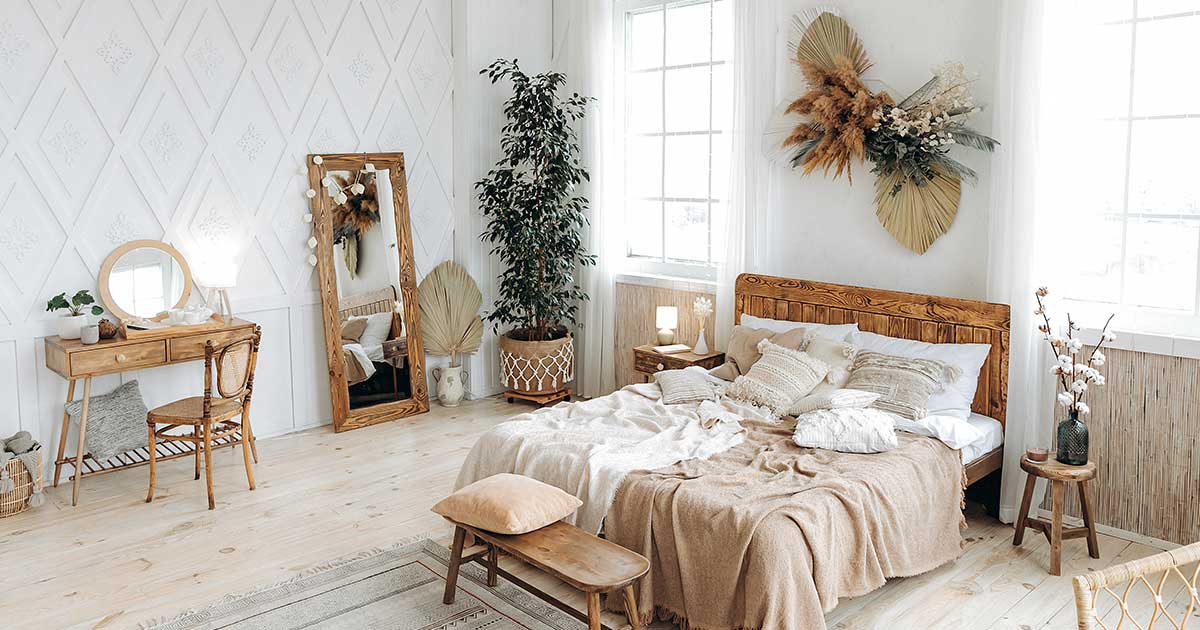 Hey there! Let’s discuss something important but often overlooked: turning your bedroom into a true sanctuary for rest and rejuvenation. Imagine a place where you can truly unwind, free from the invisible toxins that sneakily compromise our health and well-being. Yes, I’m talking about detoxifying your bedroom, and trust me, it’s not just about aesthetics; it’s about your health, your sleep, and how you feel every day.
Hey there! Let’s discuss something important but often overlooked: turning your bedroom into a true sanctuary for rest and rejuvenation. Imagine a place where you can truly unwind, free from the invisible toxins that sneakily compromise our health and well-being. Yes, I’m talking about detoxifying your bedroom, and trust me, it’s not just about aesthetics; it’s about your health, your sleep, and how you feel every day.
The Unseen Culprits: Toxins in Your Sleep Space
First off, it’s crucial to know what we’re up against. You might not realize it, but your bedroom could be home to unwelcome guests: toxic chemicals and electromagnetic fields (EMFs).
Toxic Carpets and Synthetic Bedding:
That soft, plush carpet and those silky sheets? They might feel cozy but can be loaded with chemicals like formaldehyde, flame retardants, and phthalates.[1-3] These nasties can off-gas toxic fumes right where you sleep, leading to respiratory troubles, skin irritation, and even messing with your hormones.[4] Yikes!
EMF Radiation:
Our beloved gadgets and convenience tech also have a downside. EMFs from cell phones, Wi-Fi routers, and even power lines can affect sleep. Research shows that EMF exposure can reduce your body’s natural sleep rhythms, making it hard to catch those Z’s.[5] It’s not exactly what you want in your relaxation zone.
Detoxifying Your Bedroom: Steps to a Toxin-Free Haven
Let’s get down to business and clean up our sleep space. Here’s how:
Kick Toxic Carpets and Bedding to the Curb:
Start by saying goodbye to synthetic carpets and bedding. Opt for natural fibers like wool or organic cotton for your rugs and sheets. These are safer, feel amazing, and support sustainable practices.[1-3]
Tone Down the EMFs:
Create an EMF-free oasis. Power down those electronics well before bedtime, and keep them out of the bedroom entirely. Consider EMF-blocking curtains or paint if you’re really looking to minimize exposure and make your bedroom a tech-free sanctuary.[5]
Choose a Non-Toxic Mattress:
Your mattress is key to good sleep, but many are packed with chemicals. Look for one made from organic materials like natural latex, organic cotton, or wool. Not only do they skip the toxic chemicals, but they’re also super comfy and support your body just right.[1-3]
Let Fresh Air In:
Nothing beats fresh air for a clean, healthy bedroom. Crack a window to let the breeze sweep away pollutants, or use an air purifier to keep the air in your room clean and fresh.[6] It’s a simple step with big benefits for your sleep and health.
Reduce VOCs:
Volatile organic compounds (VOCs) are everywhere – in paint, furniture, and cleaning products.[4] Go for low-VOC or VOC-free options to keep your air quality top-notch. And if you’re bringing in new furniture or freshly painted items, give them time to off-gas in a well-ventilated space before introducing them to your bedroom.
Wrapping It Up: Your Bedroom, Your Sanctuary
Creating a healthy, toxin-free bedroom might seem like a bit of work, but it’s totally worth it. Not only will you sleep better, but you’ll also feel more refreshed and ready to tackle your day. Small changes, like switching to natural bedding or improving ventilation, can significantly affect your sleep quality and overall health.
So, take a little time to assess your bedroom and make those tweaks where needed. Your body (and your mind) will thank you for it. Here’s to sweet dreams and waking up feeling rejuvenated every single day!
Remember, Detoxifying Your Bedroom into a non-toxic sanctuary involves making conscious choices that benefit your health and well-being. Whether opting for natural materials, minimizing EMF exposure, or ensuring your air is clean and fresh, each step brings you closer to a restorative sleep experience. So, why not start today? Your perfect, healthy haven awaits!
References:
- Liang, Yirui, and Ying Xu. “Emission of phthalates and phthalate alternatives from vinyl flooring and crib mattress covers the influence of temperature.” Environmental science & technology vol. 48,24 (2014): 14228-37. doi:10.1021/es504801x
- “Flame Retardants.” National Institute of Environmental Health Sciences, U.S. Department of Health and Human Services, www.niehs.nih.gov/health/topics/agents/flame_retardants. Accessed 20 Feb. 2024.
- “Endocrine Disruptors.” National Institute of Environmental Health Sciences, U.S. Department of Health and Human Services, www.niehs.nih.gov/health/topics/agents/endocrine. Accessed 20 Feb. 2024.
- David, Elena, and Violeta-Carolina Niculescu. “Volatile Organic Compounds (VOCs) as Environmental Pollutants: Occurrence and Mitigation Using Nanomaterials.” International Journal of Environmental Research and Public Health vol. 18,24 13147. 13 Dec. 2021, doi:10.3390/ijerph182413147
- Barsam, Tayebeh, et al. “Effect of extremely low-frequency electromagnetic field exposure on sleep quality in high voltage substations.” Iranian Journal of Environmental Health Science & Engineering vol. 9,1 15. 30 Nov. 2012, doi:10.1186/1735-2746-9-15
- “Improving Ventilation in Your Home.” Centers for Disease Control and Prevention, www.cdc.gov/coronavirus/2019-ncov/prevent-getting-sick/improving-ventilation-home.html. Accessed 20 Feb. 2024




Leave a Reply
Your email is safe with us.